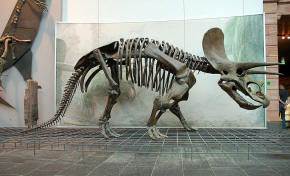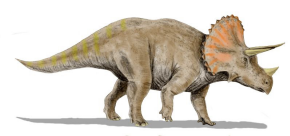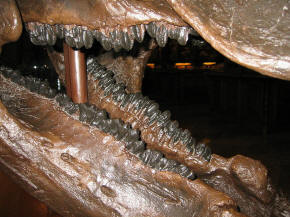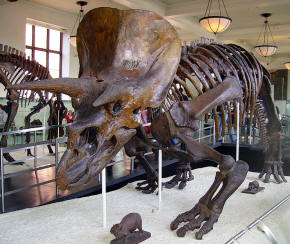probably low growth,
although they may have been able to knock down taller plants with their
horns, beak, and bulk. The
jaws were tipped with a
deep, narrow beak, believed to have been better at grasping and plucking
than biting.
Triceratops
teeth were arranged in
groups called batteries, of 36 to 40 tooth columns, in each side of each jaw
with 3 to 5 stacked teeth per column, depending on the size of the animal.
This gives a range of 432 to 800 teeth, of which only a fraction were in use
at any given time (tooth replacement was continuous and occurred throughout
the life of the animal). They functioned by shearing in a vertical to
near-vertical orientation. The great size and numerous teeth of
Triceratops suggests that
they ate large volumes of fibrous plant material, with some suggesting
palms and cycads, and others
suggesting ferns, which then grew
in prairies.
Functions
of the horns and frill
There has been much speculation over
the functions of Triceratops'
head adornments. The
two main theories have revolved around use in combat,
or display in courtship, with the latter thought now to be the most likely
primary function.
Early on, Lull postulated that the frills may have served
as anchor points for the jaw muscles to aid chewing by allowing increased
size and thus power for the muscles. This has been put forward by other
authors over the years, but later studies do not find evidence of large
muscle attachments on the frill bones.
Triceratops
were long thought to have possibly used their horns and frills in combat
with predators such as
Tyrannosaurus, the
idea being discussed first by
C. H. Sternberg in 1917
and 70 years later by Robert Bakker. There is evidence that
Tyrannosaurus did have
aggressive head-on encounters with Triceratops,
based on partially healed tyrannosaur tooth marks on a
Triceratops brow horn and
squamosal; the bitten
horn is also broken, with new bone growth after the break. Which animal was
the aggressor is not known. Tyrannosaurus
is also known to have fed on Triceratops.
Evidence for this includes a heavily tooth-scored
Triceratops
ilium and
sacrum.
In addition to combat with predators
using horns, Triceratops
are classically shown engaging each other in combat with horns locked. While
studies show that such activity would be feasible, if unlike that of
present-day horned animals, there is disagreement about whether they
actually did so. Additionally, although pitting, holes, lesions, and other
damage on Triceratops
skulls (and the skulls of other ceratopsids) are often attributed to horn
damage in combat, a recent study finds no evidence for horn thrust injuries
causing these forms of damage (for example, there is no evidence of
infection or healing). Instead, non-pathological
bone resorption, or
unknown bone diseases, are suggested as causes. However, a newer study
compared incidence rates of skull lesions in
Triceratops and
Centrosaurus and
showed that these were consistent with
Triceratops using its horns in combat and the
frill being adapted as a protective structure, while lower pathology rates
in Centrosaurus may
indicate visual rather than physical use of cranial ornamentation, or a form
of combat focused on the body rather than the head. The researchers also
concluded that the damage found on the specimens in the study was often too
localized to be caused by bone disease.
The large frill also may have helped
to increase body area to regulate body temperature.
A similar theory has been proposed regarding the plates of
Stegosaurus, although
this use alone would not account for the bizarre and extravagant variation
seen in different members of the
Ceratopsidae. This
observation is highly suggestive of what is now believed to be the primary
function, display.
The theory of their use in sexual
display was first proposed by Davitashvili in 1961 and has gained increasing
acceptance since. Evidence that visual display was important, either in
courtship or in other social behavior, can be seen in the fact that horned
dinosaurs differ markedly in their adornments, making each species highly
distinctive. Also, modern living creatures with such displays of horns and
adornments use them in similar behavior. A recent study of the smallest
Triceratops skull,
ascertained to be a juvenile, shows the frill and horns developed at a very
early age, predating sexual development and thus probably important for
visual communication and species recognition in general. The large eyes and
shortened features, a hallmark of "cute" baby animals, also suggest that the
parent Triceratops
may have cared for its young.
Depiction
in recent popular media
The distinctive appearance of
Triceratops has led to
them being frequently depicted in films, computer games and documentaries,
including the Don Bluth film
The Land Before Time,
which featured a young Triceratops
as a main character, the 1993 film
Jurassic Park and the
1999 BBC television
documentary
Walking with Dinosaurs.
Triceratops (the
species are not identified) is the official state fossil of South Dakota, and the
official state dinosaur of Wyoming.
A recurring theme, especially in
children's dinosaur books, is a climactic showdown or battle between
Triceratops and
Tyrannosaurus. In 1942,
Charles R. Knight
painted a mural incorporating a confrontation between the two dinosaurs in
the
Field Museum of Natural History
for the National Geographic Society,
establishing them as enemies in popular thought. Paleontologist Bob Bakker said of the
imagined rivalry between
Tyrannosaurus
and Triceratops,
"No matchup between predator and prey has ever been more dramatic. It's
somehow fitting that those two massive antagonists lived out their
co-evolutionary belligerence through the very last days of the very last
epoch of the Age of Dinosaurs."
If you ordered the Test Pack, it is now time to
take Test 10.
Return to the
Old Earth Ministries Online Dinosaur
Curriculum homepage.




